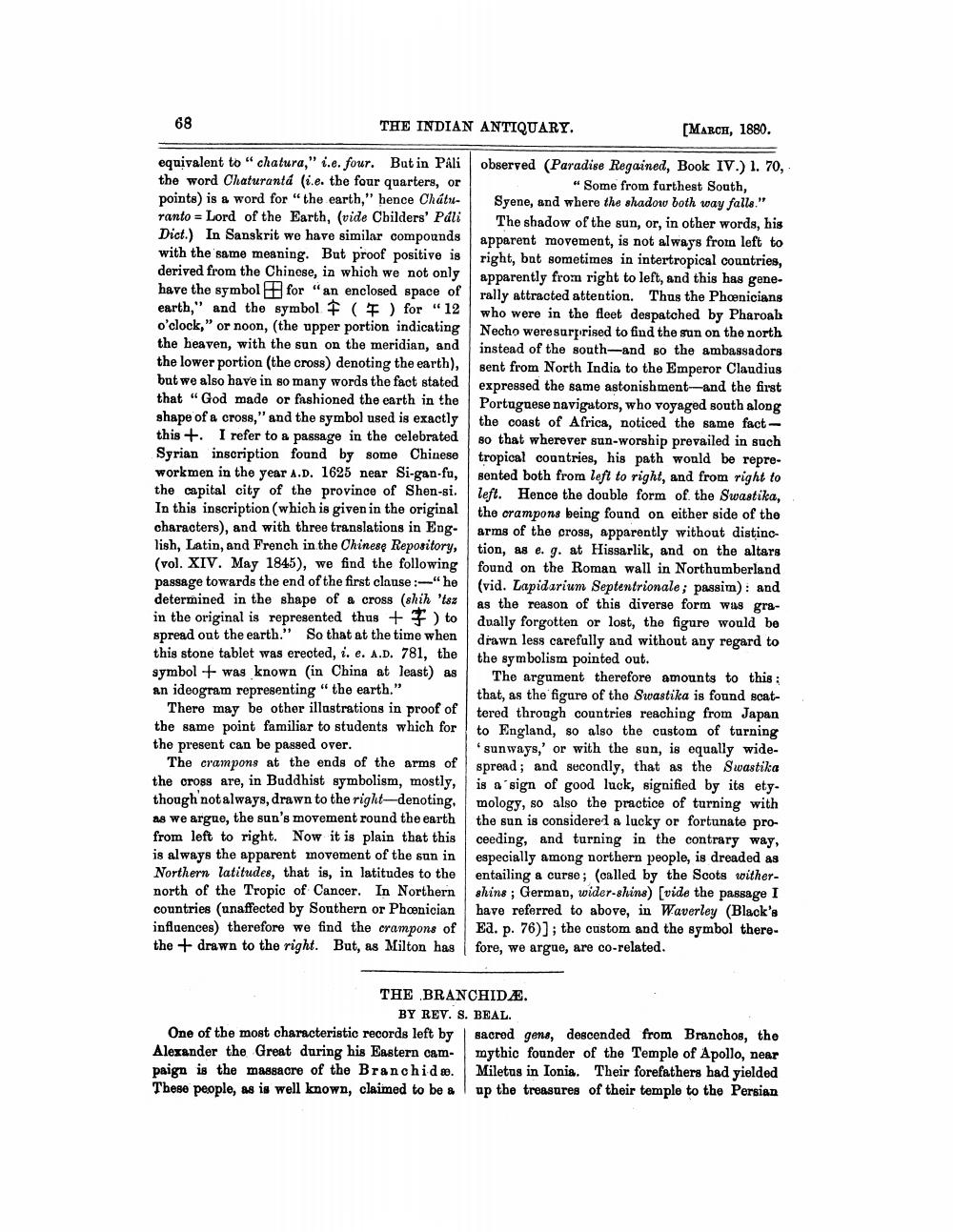________________
68
THE INDIAN ANTIQUARY.
[MARCH, 1880.
equivalent to "chatura," i.e. four. But in Páli observed (Paradise Regained, Book IV.) 1. 70, the word Chaturanta (i.e. the four quarters, or
"Some from farthest South, points) is a word for the earth," hence Chátu- Syene, and where the shadow both way falls." ranto = Lord of the Earth, (vide Childers' Pali The shadow of the sun, or, in other words, his Dict.) In Sanskrit we have similar compounds
apparent movement, is not always from left to with the same meaning. But proof positive is right, but sometimes in intertropical countries, derived from the Chinese, in which we not only apparently from right to left, and this has genehave the symbol for “an enclosed space of
rally attracted attention. Thus the Phoenicians earth," and the symbol () for "12
who were in the fleet despatched by Pharoah o'clock," or noon, (the upper portion indicating Necho weresurprised to find the sun on the north the heaven, with the sun on the meridian, and instead of the south-and so the ambassadors the lower portion (the cross) denoting the earth), sent from North India to the Emperor Claudius but we also have in so many words the fact stated
expressed the same astonishment and the first that “God made or fashioned the earth in the Portuguese navigators, who voyaged south along shape of a cross," and the symbol used is exactly the coast of Africa, noticed the same fact - this+. I refer to a passage in the celebrated 80 that wherever sun-worship prevailed in such Syrian inscription found by some Chinese tropical countries, his path would be repreworkmen in the year A.D. 1625 near Si-gan-fu, sented both from left to right, and from right to the capital city of the province of Shen-si. left. Hence the double form of the Swastika, In this inscription (which is given in the original the crampons being found on either side of the characters), and with three translations in Eng.
arms of the cross, apparently without distinclish, Latin, and French in the Chinese Repository, tion, as e. g. at Hissarlik, and on the altars (vol. XIV. May 1845), we find the following found on the Roman wall in Northumberland passage towards the end of the first clause :-" he
(vid. Lapidarium Septentrionale; passim): and determined in the shape of a cross (shih 'tsz
as the reason of this diverse form was grain the original is represented thus + F) to
dually forgotten or lost, the figure would be spread out the earth." So that at the time when drawn less carefully and without any regard to this stone tablet was erected, i. e. A.D. 781, the
the symbolism pointed out. symbol+ was known in China at least) as
The argument therefore amounts to this: an ideogram representing " the earth."
that, as the figure of the Swastika is found scatThere may be other illustrations in proof of tered through countries reaching from Japan the same point familiar to students which for to England, so also the custom of turning the present can be passed over.
sunways,' or with the sun, is equally wideThe crampons at the ends of the arms of
sprend; and secondly, that as the Swastika the cross are, in Buddhist symbolism, mostly, is a sign of good luck, signified by its ety. though not always, drawn to the right-denoting, | mology, so also the practice of turning with as we argue, the sun's movement round the earth the sun is considered a lucky or fortunate profrom left to right. Now it is plain that this ceeding, and turning in the contrary way, is always the apparent movement of the sun in especially among northern people, is dreaded as Northern latitudes, that is, in latitudes to the entailing a curse; (called by the Soots withernorth of the Tropic of Cancer. In Northern shins ; German, wider-shins) [vide the passage I countries (unaffected by Southern or Phoenician have referred to above, in Waverley (Black's influences) therefore we find the crampons of Ea. p. 76)]; the custom and the symbol there. the + drawn to the right. But, as Milton has fore, we argue, are co-related.
THE BRANCHIDÆ.
BY REV. S. BEAL. One of the most characteristic records left by sacred gens, descended from Branchos, the Alexander the Great during his Eastern cam- mythic founder of the Temple of Apollo, near paign is the massacre of the Branchide. Miletus in Ionia. Their forefathers had yielded These people, as is well known, claimed to be a up the treasures of their temple to the Persian




